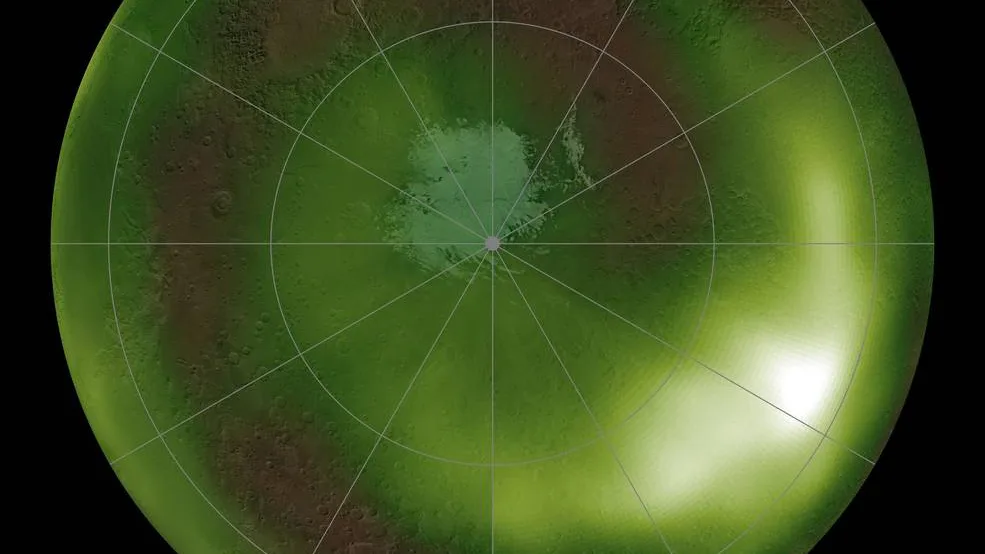
Eerie 'nightglow' reveals mysterious Martian weather patterns
"If we're going to send people to Mars, we better understand what's going on in the atmosphere."
Something unusual is going on in the atmosphere of Mars. Tracking the planet's eerie ultraviolet 'nightglow' has revealed two mysterious weather patterns that defy explanation - a persistent bright spot in the glow that keeps reappearing over the same place on the planet, and an immense spiral pattern that covers nearly the entire southern hemisphere.
High above Earth and Mars, intense ultraviolet light from the Sun splits apart molecules into their component atoms. When those atoms come together, they release their own light, resulting in a persistent glow. At Earth, this shows up as a thin band of yellow-green known as 'airglow', which is caused by oxygen breaking apart and reforming along the edge of the atmosphere. We often see this phenomenon in videos taken from the International Space Station.
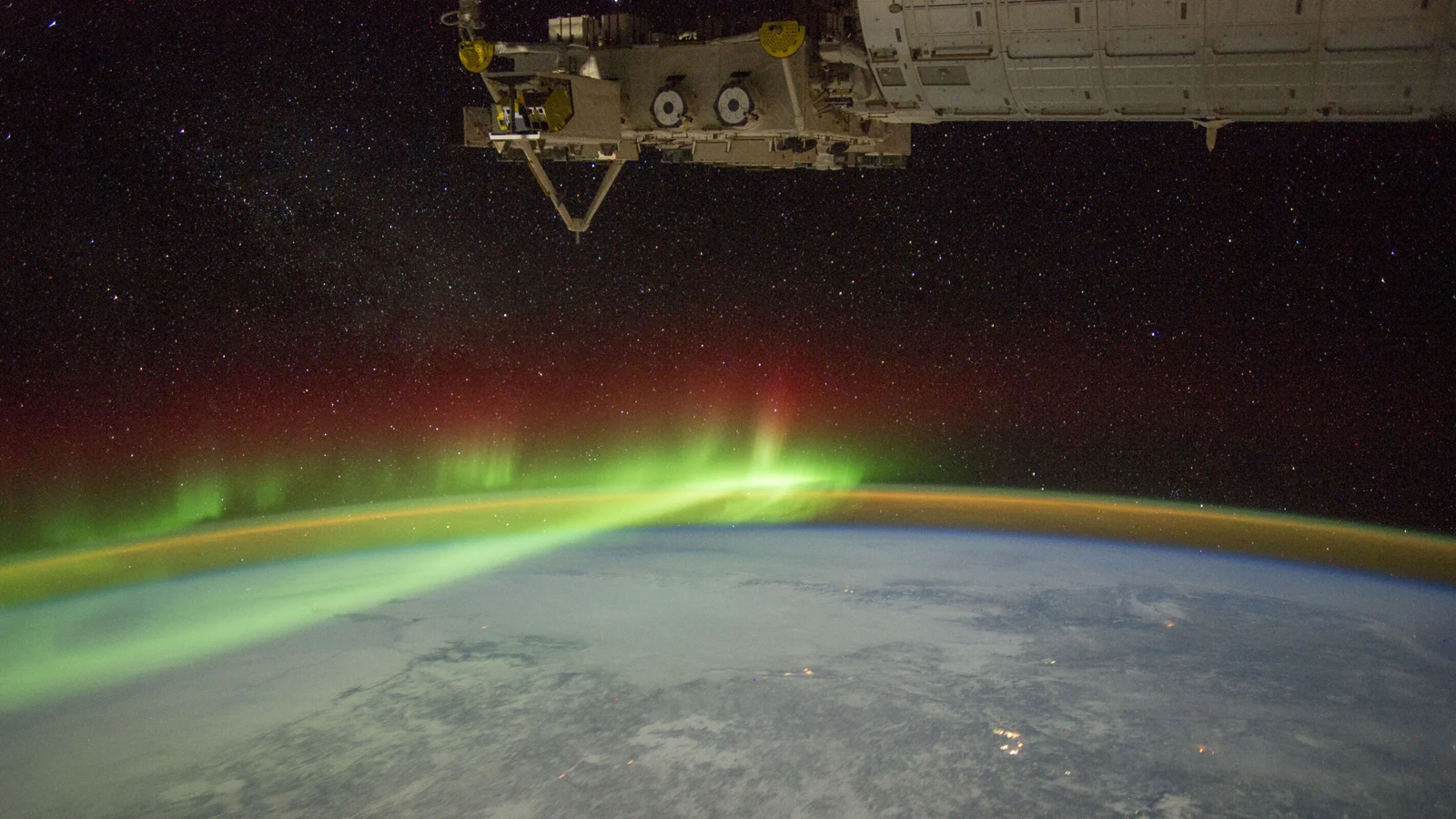
This view from the ISS from 2015 shows auroras (left), and the yellow-green band of airglow at the top of the atmosphere. Credit: NASA/JSC/ESRS
On Mars, as with all things about the Red Planet, this glow is a bit different. Firstly, while airglow on Earth is produced by oxygen, Mars' nightglow comes from oxygen and nitrogen atoms joining together to form nitric oxide. Secondly, scientists studying it call it 'nightglow', because it is only detected in the hours after sunset. And thirdly, it is effectively invisible to human eyes. The only way to detect it is with a special sensor that is sensitive to ultraviolet light, such as the Imaging UltraViolet Spectrograph on NASA's MAVEN spacecraft.
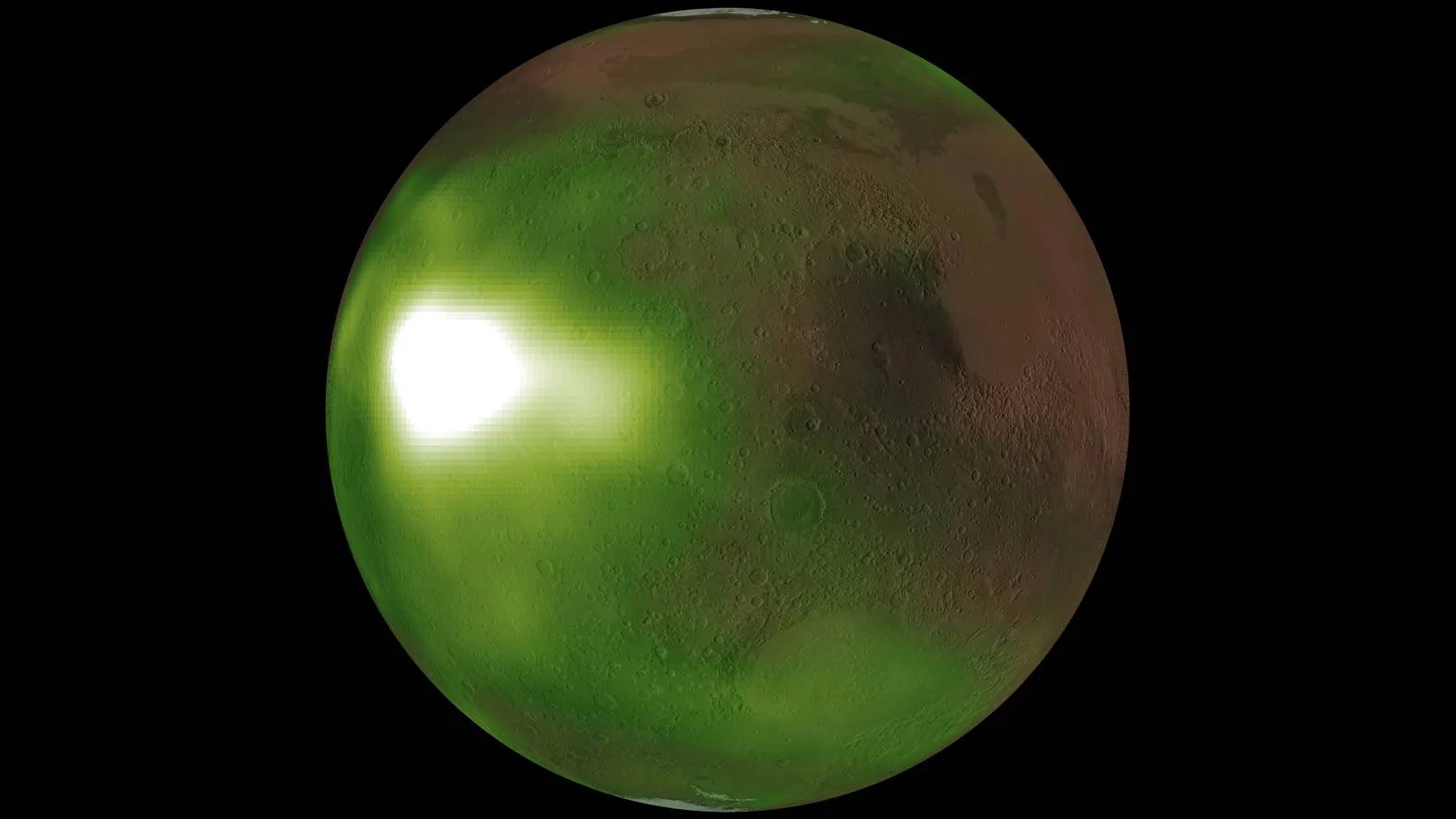
The ultraviolet 'nightglow' in the Martian atmosphere is overlaid onto the Mars globe here, in green and white false colours to represent the intensity of ultraviolet light (white being the brightest). An intense brightening is shown in Mars' nightside atmosphere, which occurs regularly after sunset on Martian evenings during fall and winter seasons, and fades by midnight. Credit: NASA/MAVEN/Goddard Space Flight Center/CU/LASP
"The ultraviolet glow comes mostly from an altitude of about 70 kilometres, with the brightest spot about a thousand kilometres across, and is as bright in the ultraviolet as Earth's northern lights," Zac Milby, a research assistant at the University of Colorado's Laboratory for Atmospheric and Space Physics, said in a NASA press release.
"Unfortunately, the composition of Mars' atmosphere means that these bright spots emit no light at visible wavelengths that would allow them to be seen by future Mars astronauts," Milby added. "Too bad: the bright patches would intensify overhead every night after sunset, and drift across the sky at 300 kilometres per hour."
The bright region of the nightglow, as shown above, shows up as a result of waves of rising and sinking air in the Martian atmosphere. Tracing how nightglow changes from day to day can help track these waves in the atmosphere, the researchers say.
According to NASA: "The number of waves and their speed indicates that Mars' middle atmosphere is influenced by the daily pattern of solar heating and disturbances from the topography of Mars' huge volcanic mountains. These pulsating spots are the clearest evidence that the middle atmosphere waves match those known to dominate the layers above and below."
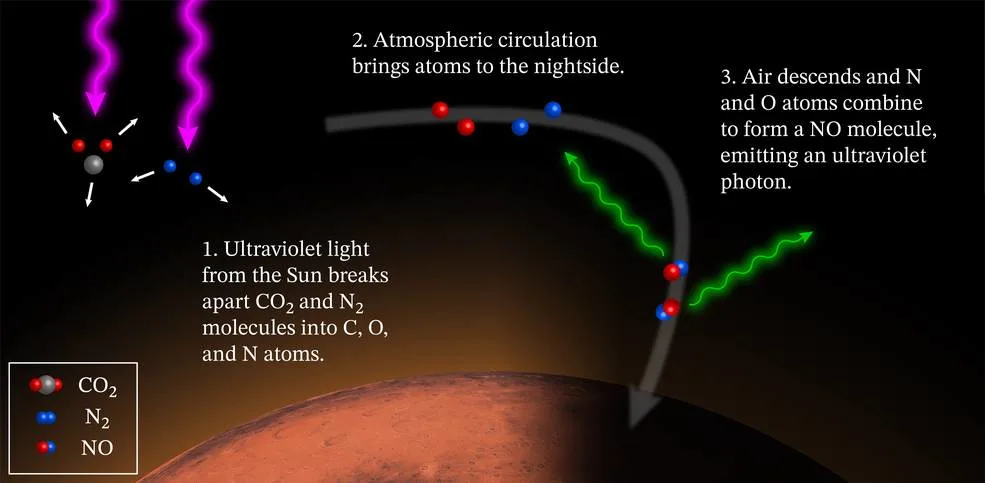
This diagram explains the process of nightglow high above Mars. Credit: NASA/MAVEN/Goddard Space Flight Center/CU/LASP
MARS' WEATHER MYSTERIES
Scientists know quite a bit about how Mars' nightglow forms, and its daily and seasonal patterns. They've even traced the way it pulses. Two aspects of it are currently stumping them, though.
The first is the immense spiral pattern the glow apparently follows in the southern hemisphere.
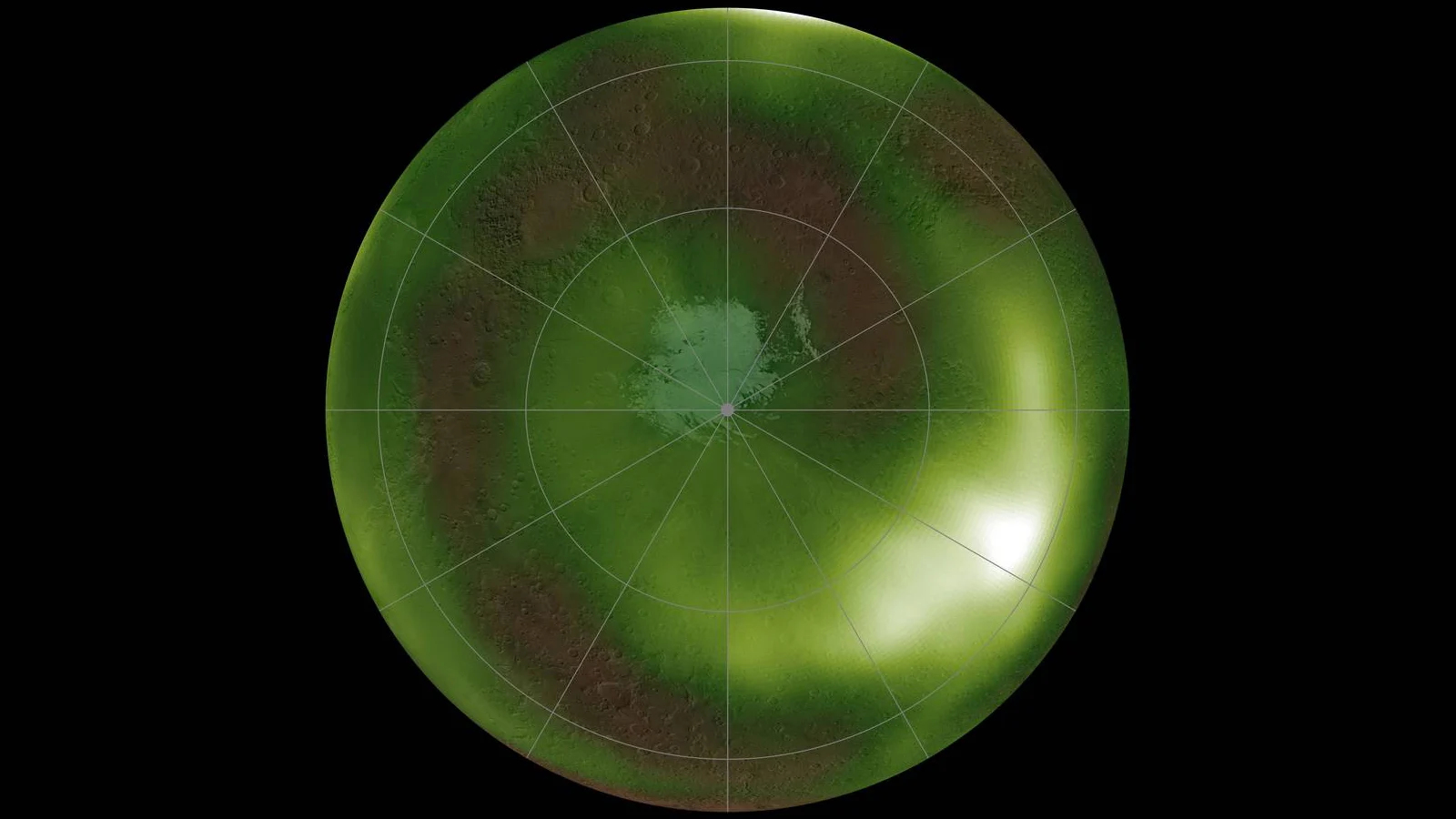
This view shows Mars' 'nightglow' as it would appear looking straight down over the south pole. A simulated view of the Mars globe is added for context. The glow follows an unexpectedly bright spiral pattern that wraps around the entire hemisphere. Credit: NASA/MAVEN/Goddard Space Flight Center/CU/LASP
While the glow's position and shape changes and shifts as the planet rotates, there is currently no explanation for why it follows such a distinct pattern centred over the south pole.
The other mystery is why one of the bright spots in the glow keeps appearing and disappearing in the same spot, centred just to the east of 0° latitude and 0° longitude.
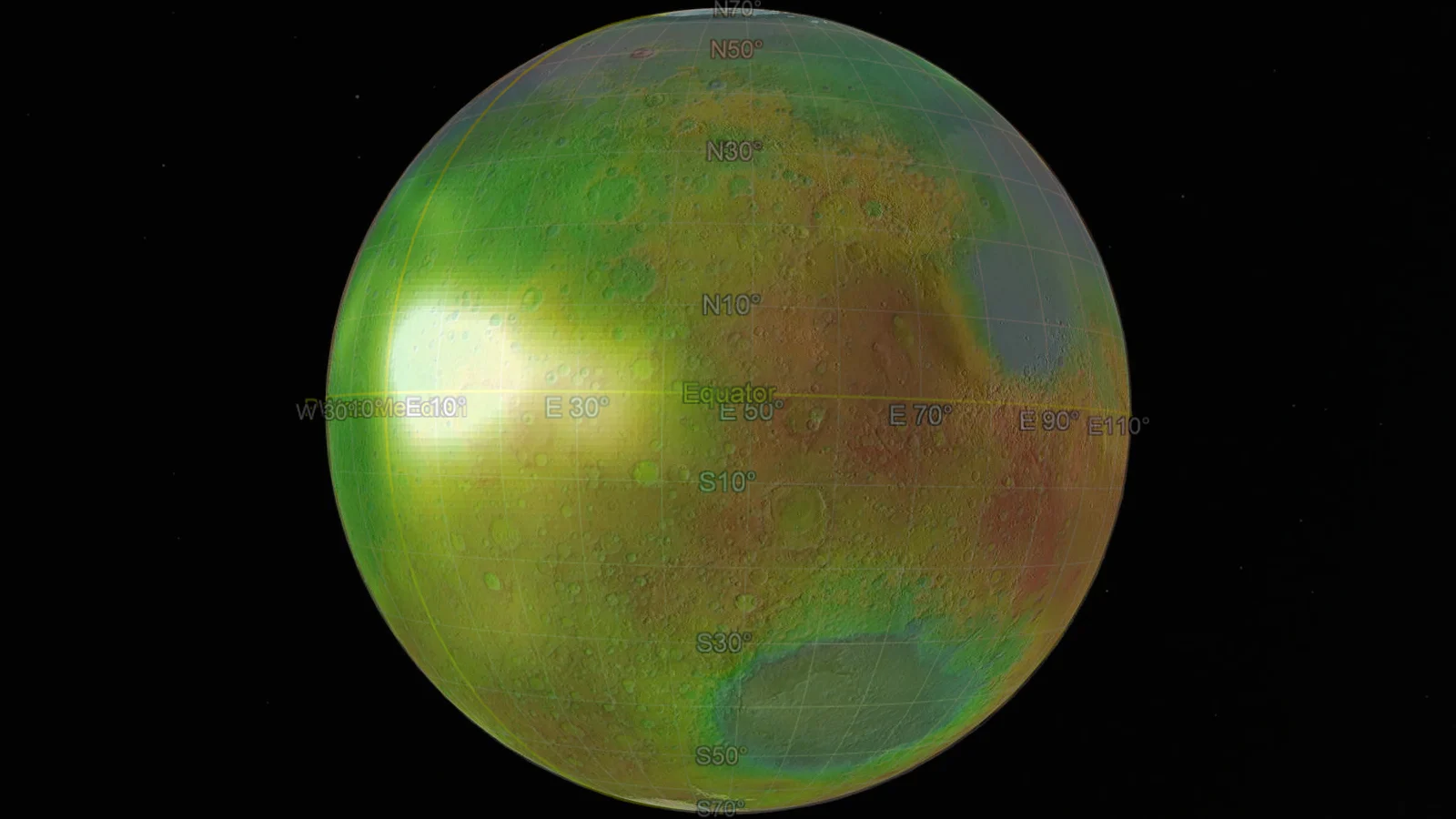
This composite image overlays Google Earth's Mars globe, complete with lines of latitude and longitude, overtop of MAVEN's map of the nightglow bright spot. Credit: NASA/MAVEN/Goddard Space Flight Center/CU/LASP/Google Earth/Scott Sutherland
The location of Mars' Prime Meridian was set arbitrarily, nearly two hundred years ago, by German astronomers W. Beer and J. H. Mädler. They simply picked one easily located landmark on the surface to track the rotation of the planet. At the intersection of the Prime Merdian and the Equator is Meridiani Planum, near where NASA's Opportunity rover set down over 15 years ago.
There doesn't seem to be any specific reason why the atmospheric waves, and thus the nightglow, would favour this region of the planet. It may have something to do with the terrain of Meridiani Planum. Maybe it's due to the area being downwind of Mars' collection of immense extinct volcanoes, which includes Olympus Mons.
"The behaviour of the Martian atmosphere is every bit as complicated and insightful as that of Earth's atmosphere," Nick Schneider, the University of Colorado professor who led this study of Mars' nightglow, told CU Boulder Today.
According to Schneider, further study of Mars' nightglow is expected to reveal more about its dynamics, and thus more about the behaviour of Mars' atmosphere. That, in turn, will help improve models of Mars' atmosphere, to provide better weather forecasts for the Red Planet.
"If we're going to send people to Mars, we better understand what's going on in the atmosphere," Milby said.
Sources: NASA | UC Boulder Today | ESA











